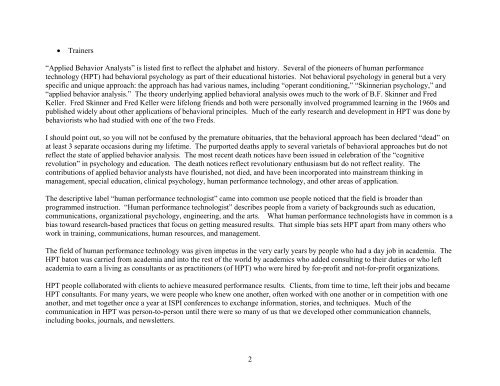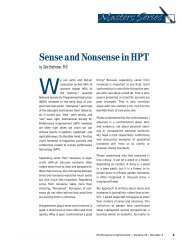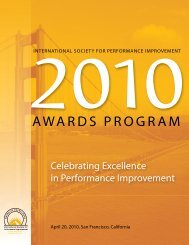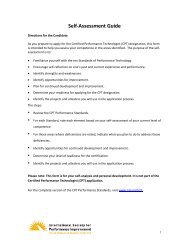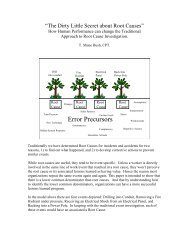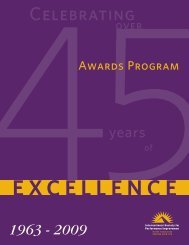Yes We Can! - International Society for Performance Improvement
Yes We Can! - International Society for Performance Improvement
Yes We Can! - International Society for Performance Improvement
You also want an ePaper? Increase the reach of your titles
YUMPU automatically turns print PDFs into web optimized ePapers that Google loves.
• Trainers<br />
“Applied Behavior Analysts” is listed first to reflect the alphabet and history. Several of the pioneers of human per<strong>for</strong>mance<br />
technology (HPT) had behavioral psychology as part of their educational histories. Not behavioral psychology in general but a very<br />
specific and unique approach: the approach has had various names, including “operant conditioning,” “Skinnerian psychology,” and<br />
“applied behavior analysis.” The theory underlying applied behavioral analysis owes much to the work of B.F. Skinner and Fred<br />
Keller. Fred Skinner and Fred Keller were lifelong friends and both were personally involved programmed learning in the 1960s and<br />
published widely about other applications of behavioral principles. Much of the early research and development in HPT was done by<br />
behaviorists who had studied with one of the two Freds.<br />
I should point out, so you will not be confused by the premature obituaries, that the behavioral approach has been declared “dead” on<br />
at least 3 separate occasions during my lifetime. The purported deaths apply to several varietals of behavioral approaches but do not<br />
reflect the state of applied behavior analysis. The most recent death notices have been issued in celebration of the “cognitive<br />
revolution” in psychology and education. The death notices reflect revolutionary enthusiasm but do not reflect reality. The<br />
contributions of applied behavior analysts have flourished, not died, and have been incorporated into mainstream thinking in<br />
management, special education, clinical psychology, human per<strong>for</strong>mance technology, and other areas of application.<br />
The descriptive label “human per<strong>for</strong>mance technologist” came into common use people noticed that the field is broader than<br />
programmed instruction. “Human per<strong>for</strong>mance technologist” describes people from a variety of backgrounds such as education,<br />
communications, organizational psychology, engineering, and the arts. What human per<strong>for</strong>mance technologists have in common is a<br />
bias toward research-based practices that focus on getting measured results. That simple bias sets HPT apart from many others who<br />
work in training, communications, human resources, and management.<br />
The field of human per<strong>for</strong>mance technology was given impetus in the very early years by people who had a day job in academia. The<br />
HPT baton was carried from academia and into the rest of the world by academics who added consulting to their duties or who left<br />
academia to earn a living as consultants or as practitioners (of HPT) who were hired by <strong>for</strong>-profit and not-<strong>for</strong>-profit organizations.<br />
HPT people collaborated with clients to achieve measured per<strong>for</strong>mance results. Clients, from time to time, left their jobs and became<br />
HPT consultants. For many years, we were people who knew one another, often worked with one another or in competition with one<br />
another, and met together once a year at ISPI conferences to exchange in<strong>for</strong>mation, stories, and techniques. Much of the<br />
communication in HPT was person-to-person until there were so many of us that we developed other communication channels,<br />
including books, journals, and newsletters.<br />
2


